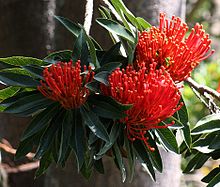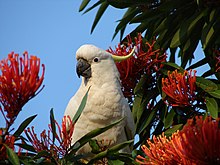Alloxylon flammeum
| Alloxylon flammeum | |
|---|---|

| |
| Scientific classification | |
| Kingdom: | Plantae |
| Clade: | Tracheophytes |
| Clade: | Angiosperms |
| Clade: | Eudicots |
| Order: | Proteales |
| Family: | Proteaceae |
| Genus: | Alloxylon |
| Species: | A. flammeum
|
| Binomial name | |
| Alloxylon flammeum Crisp[2] | |

| |
| Range of A. flammeum in north Queensland | |
Alloxylon flammeum, commonly known as the Queensland tree waratah or red silky oak, is a medium-sized tree of the family
Alloxylon flammeum is a canopy or emergent tree of the Mabi rainforest community of north Queensland. Its terminal tubular flowers indicate that the species is pollinated by birds. Readily adaptable to cultivation, Alloxylon flammeum prefers a site with good drainage and responds well to extra moisture and fertilisers low in phosphorus. It is listed nationally as vulnerable under the Australian Environment Protection and Biodiversity Conservation Act 1999 (EPBC Act) as most of its habitat has been cleared for agriculture and logging.
Description

In nature, this is a rainforest tree that can reach 33 m (108 ft) in height with a
Occurring in spring (August to October), the bright red or orange-red
Alloxylon flammeum can be distinguished from the co-occurring Alloxylon wickhamii by its hairy stems and petioles.[3] It also has brighter flowers than the latter species.[4] The New Guinean species A. brachycarpum resembles A. flammeum but has duller flowers, leaves that are shorter and wider, and fewer hairs on its perianth.[3] A. pinnatum has pinnate (lobed) adult leaves and larger inflorescences made up of 50 to 140 individual flowers. It also has crimson pollen rather than the yellow of A. flammeum.[5]
Taxonomy
For many years Alloxylon flammeum was mistakenly known as Embothrium (and later Oreocallis) wickhamii—Queensland botanist Frederick Manson Bailey had illustrated it using Embothrium wickhamii in the Queensland Agricultural Journal in 1899. Ferdinand von Mueller had described what is now known as Alloxylon wickhamii but also collected material of A. flammeum at Trinity Bay in 1881, not realising it was a separate species.[5]
It was only in the 1980s that botanists realised there were two species in the region—Oreocallis wickhamii and what became known as Oreocallis sp. nova.
Alloxylon flammeum and the other three tree waratah species lie in the subtribe Embothriinae, along with the true waratahs (Telopea), South American Oreocallis, and Chilean firetree (Embothrium coccineum) from South America.[8][9] Almost all these species have red terminal flowers, and hence the subtribe's origin and floral appearance most likely predate the splitting of Gondwana into Australia, Antarctica, and South America over 60 million years ago.[10] The position, colour and tubular shape of the flowers suggest they are bird-pollinated,[3] and have been so since the Eocene radiation of nectar-feeding birds such as honeyeaters.[11] Cladistic analysis of morphological features within the Embothriinae showed A. flammeum and A. brachycarpum to be sister species, with A. wickhamii as their next closest relative.[12] A. flammeum has yellow pollen grains, like A. brachycarpum and A. wickhamii but unlike all other members of the Embothriinae.[12]
Distribution and habitat
A plant of the
Conservation status
Alloxylon flammeum is listed nationally as vulnerable under the Australian Environment Protection and Biodiversity Conservation Act 1999 (EPBC Act),[1] which indicates that there is a high risk it will become extinct in the wild in the mid-term future.[16] Before the establishment of the EPBC Act, it was, and currently remains, listed as vulnerable under the state-based Nature Conservation Act 1992.[15][17] Furthermore, it was listed by the International Union for Conservation of Nature (IUCN) in 1997.[18] Most of its habitat has been cleared for agriculture and development. Remaining stands in protected areas are highly fragmented. Furthermore, plants in cultivation are likely to come from a limited genetic pool.[15] With under 2% of its original extent remaining, the rainforest is threatened by invasive plants and grazing by feral and domestic animals.[14]
Cultivation

Although it is not widely cultivated, Alloxylon flammeum has proven to be by far the most hardy and adaptable (as well as the showiest) member of the genus Alloxylon,
Propagation is generally by seed although semi-hardened cuttings have also been successful. Cuttings can be slow to strike, and the resulting plants may have weak root systems early on and need to be supported with stakes.[4] Semi-hardened cuttings have been most successful in experiments applying the rooting hormone indole-3-butyric acid at 8000 milligrams per litre concentration, intermittent misting, and a warmer root temperature of 24 °C (75 °F).[20] Plants grown from seed may take seven or eight years to flower,[19] with flowering occurring soon after the foliage changes from juvenile to adult leaves.[21] An alternative method used has been to graft mature scions onto young stock to combine a strong root system with material capable of flowering quickly.[21] The species has also been considered as a rootstock for the considerably harder to grow A. pinnatum.[20] Alloxylon flammeum has potential as a cut flower crop.[20] Its soft silky timber resembles that of oak and is highly regarded.[7]
References
- ^ a b Department of Sustainability, Environment, Water, Population and Communities (13 March 2012). "Alloxylon flammeum – Red Silky Oak, Queensland Waratah, Tree Waratah". Species Profile and Threats Database. Canberra, Australian Capital Territory: Commonwealth of Australia. Retrieved 14 December 2012.
{{cite web}}: CS1 maint: multiple names: authors list (link) - ^ a b c "Alloxylon flammeum P.H.Weston & Crisp". Australian Plant Name Index (APNI), IBIS database. Canberra, Australian Capital Territory: Centre for Plant Biodiversity Research, Australian Government. Retrieved 5 January 2013.
- ^ ISBN 0-643-05693-9. Retrieved 29 Nov 2013.
- ^ ISBN 0-85091-696-8.
- ^ .
- ^ ISBN 0-207-17277-3.
- ^ Commonwealth Scientific and Industrial Research Organisation(CSIRO). Retrieved 2 March 2021.
- .
- .
- ISBN 0-86417-878-6.
- S2CID 86156197.
- ^ .
- ^ Tracey, J. G. (John Geoffrey) (1982), The Vegetation of the Humid Tropical Region of North Queensland, p. 25
- ^ a b Mabi Forest Working Group. "Vanishing Vegetation of Far North Queensland: Mabi (5b) Forest" (PDF). Atherton, Queensland: TREAT (Trees for the Evelyn and Atherton Tablelands Inc). Retrieved 2014-03-22.
- ^ a b c Department of Sustainability, Environment, Water, Population and Communities (1 October 2008). "Approved Conservation Advice for Alloxylon flammeum (Red Silky Oak)" (PDF). Canberra, Australian Capital Territory: Australian Government.
{{cite web}}: CS1 maint: multiple names: authors list (link) - ^ Walters, Brian (April 2012). "Alloxylon flammeum". Australian Native Plants Society (Australia) website. Retrieved 22 December 2012.
- ^ Queensland Government (27 Sep 2013). "Nature Conservation (Wildlife) Regulation 2006" (PDF). Nature Conservation Act 1992. Online, accessed from www.legislation.qld.gov.au. Australia. p. 46. Retrieved 29 Nov 2013.
- ISBN 2-8317-0328-X. Retrieved 2014-03-22.
- ^ ISBN 1-74045-739-0. Retrieved 2014-03-22.
- ^ doi:10.1071/EA97106.
- ^ a b Hodge, Mervyn W. (December 2002). "The Queensland Tree Waratah". Australian Plants Online. Australian Native Plants Society (Australia). Archived from the original on 6 September 2012. Retrieved 13 December 2012.
External links
 Media related to Alloxylon flammeum at Wikimedia Commons
Media related to Alloxylon flammeum at Wikimedia Commons




